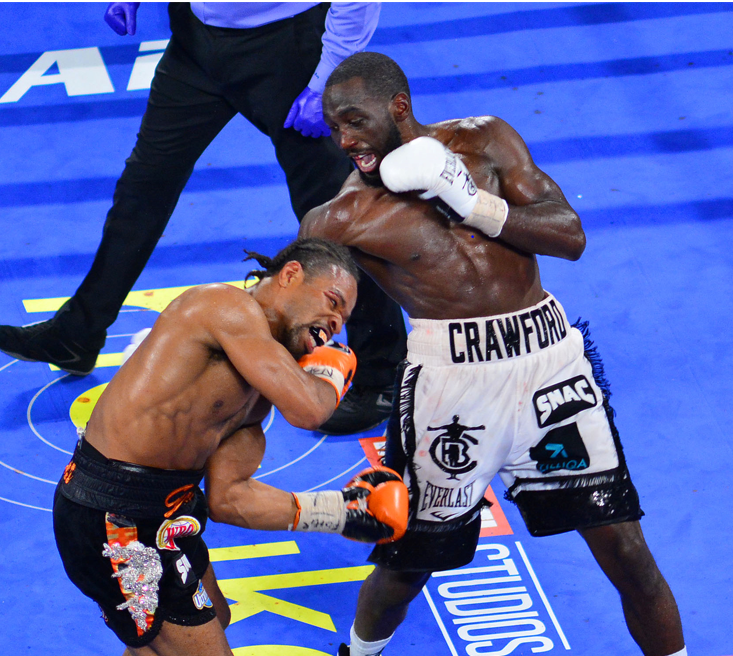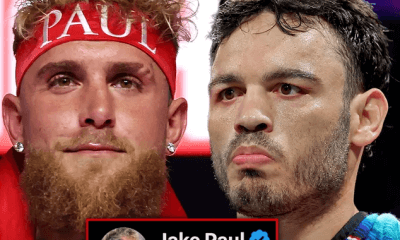Featured Articles
Crawford Stops Porter in the 10th; Porter Announces His Retirement at the Post-Fight Presser

LAS VEGAS-After tense back and forth action WBO welterweight titlist Terence Crawford unleashed one of his patented left uppercuts that began the end for “Showtime” Shawn Porter, who give all he could give, but was stopped by technical knockout on Saturday.
Porter’s father stopped the fight. And later, Porter announced his retirement in front of the media at a post-fight press conference.
But during the fight, for nearly 10 rounds Crawford (38-0, 29 KOs) seemed always on the prowl for the knockout against former two-time world champion Porter (31-4-1, 17 KOs) in front of the sold-out audience at the Mandalay Bay Resort and Casino
As always Crawford started out slowly, more intent on learning what was incoming and setting up counters. Porter took advantage with his aggressive and calculated attacks early in the welterweight world title fight.
“I did good at times but I let him work when I should have worked with him,” said Crawford.
Both fighters showed quickness and the ability to escape early traps.
But Porter was the aggressor as Crawford fought out of a southpaw stance. It wasn’t until the fourth round that the WBO champion began to open an attack. A right hook and a left uppercut scored for Crawford who fought back with two right counters.
A clash of heads in the sixth round during a furious exchange opened up a cut on Crawford, but it did not stall his mounting attack. The fighter out of Omaha, Nebraska was always on the lookout for the knockout.
Crawford opened with a sizzling four-punch salvo in the seventh round. And though Porter tried to rally he was met with a sharp one-two that left Porter shaking his head at the sound of the bell.
Porter must have realized that Crawford’s momentum was beginning to roll.
A short rally at the beginning of the eighth round by the shorter Porter was met with a sharp left cross counter. And then a left hook by Crawford landed flush and seemed to give Porter pause.
It was beginning to look like Crawford was feeling it.
Both fighters exchanged furiously in the ninth round. Crawford was getting the range for his punches and Porter’s movement was not fooling the champion anymore.
“I had to turn it up and that’s when I got the stoppage,” said Crawford.
In the 10th round, Porter charged forward with a winging attack and was countered by a Crawford left uppercut and down went the challenger. The always aggressive Porter beat the count and Crawford waited for the expected charge. It came and Crawford delivered a stunning right and crushing left that sunk Porter to his knees. He pounded the floor while on his knees in frustration.
Porter’s father and trainer Kenny Porter signaled to end the fight and the fight was ruled over by referee Celestino Ruiz at 1:21 of the 10th round.
“I got him. Once I get him on the ground I’m coming in for the kill,” Crawford said.
A huge roar erupted from the crowd of more than 12,000 fans. Crawford had won against one of the elite fighters in the welterweight class. It was a moment to relish.
“My commitment wasn’t there,” said Porter. “I let him find his comfort zone.”
Crawford said Porter’s movement and defensive abilities kept him in the game until he made a mistake.
“I didn’t get to him in the early rounds because he was head rolling,” Crawford said.
Now its on to more big names.
“Like I said before, I don’t need (Errol) Spence,” he said.
During the post-fight press conference Porter announced to the media that he was retiring.
“I’m prepared to retire,” Porter said. “I’m announcing my retirement.”
Other Bouts
A middleweight fight saw Brazil’s Esquiva Falcao (29-0, 20 KOs) win by technical split decision over Canada’s Patrice Volny (16-1, 10 KOs) due to an accidental clash of heads in the sixth round. Both fighters had their moments and Falcao was making a strong move when both fighters exchanged and Falcao broke away in pain with his gloves on his face. A laceration above his left eye forced a stoppage of the fight. The Brazilian fighter was unable to continue and according to Nevada State Athletic Commission rules, the fight was stopped and the winner decided by the scorecards. One judge ruled Volny the winner but two judges saw Falcao the victor.
Kazakhstan’s Janibek Alimkhanuly (11-1, 7 KOs) pummeled Hassan N’Dam (38-6, 21 KOs) for eight rounds until the one-side beating was stopped by referee Kenny Bayless at 2:40 of the round. Whether it was fighting from long range or short range the Kazakh fighter trained by Buddy McGirt had his way. A left uppercut floored N’Dam in the third round but he was able to survive five more rounds before it was finally stopped after a four-punch combination.
Southern California’s Raymond Muratalla (13-0 11 KOs) won by controversial stoppage over Argentina’s Elias Araujo (21-4, 8 KOs) in the fifth round of their battle of lightweight prospects.
Muratalla was able to turn and use angle to deflect Araujo’s attacks and pinpoint counter shots to the body early in the fight. In round three Muratalla, who trains at the Robert Garcia Boxing Academy in Riverside, Calif. stopped moving and began fighting inside. That’s when the power came into play.
In the fifth round both fighters fought toe to toe with Muratalla connecting solidly with right hand counters that staggered Araujo. The Argentine fighter remained slugging it out but was absorbing heavy blows to the body and head. A four-punch combination prompted referee Allen Huggins to halt the fight to the surprise of the fighter and the fans at 2:20 of the round. Fans booed the referee.
Former world champion Isaac Dogboe (23-2, 15 KOs) showed that moving up a weight division is not a problem in defeating featherweight contender Christopher Diaz (26-4, 16 KOs) by majority decision after 10 rounds. Dogboe was the aggressor throughout the fight against the defensive-minded Diaz. That proved the difference in the judges scoring in favor of Dogboe 95-95, 96-94, 97-93.
A featherweight fight between Adam Lopez (15-3, 6KOs) and Adan Ochoa (12-3, 5 KOs) that would have sold out seats back in the 1980s at the Olympic Auditorium ended in a “no decision.” The two Los Angeles-based fighters were forced to end their fight at the end of the second round due to a bad cut above the right eye of Ochoa that resulted from a headbutt. The grudge match will have to wait to find a winner.
Photo credit: Al Applerose
Check out more boxing news on video at the Boxing Channel
To comment on this story in the Fight Forum CLICK HERE
-

 Featured Articles4 weeks ago
Featured Articles4 weeks agoAvila Perspective, Chap. 330: Matchroom in New York plus the Latest on Canelo-Crawford
-

 Featured Articles3 weeks ago
Featured Articles3 weeks agoVito Mielnicki Jr Whitewashes Kamil Gardzielik Before the Home Folks in Newark
-

 Featured Articles22 hours ago
Featured Articles22 hours agoResults and Recaps from New York Where Taylor Edged Serrano Once Again
-

 Featured Articles4 weeks ago
Featured Articles4 weeks agoCatching Up with Clay Moyle Who Talks About His Massive Collection of Boxing Books
-

 Featured Articles5 days ago
Featured Articles5 days agoFrom a Sympathetic Figure to a Pariah: The Travails of Julio Cesar Chavez Jr
-

 Featured Articles3 weeks ago
Featured Articles3 weeks agoMore Medals for Hawaii’s Patricio Family at the USA Boxing Summer Festival
-

 Featured Articles1 week ago
Featured Articles1 week agoCatterall vs Eubank Ends Prematurely; Catterall Wins a Technical Decision
-

 Featured Articles4 weeks ago
Featured Articles4 weeks agoRichardson Hitchins Batters and Stops George Kambosos at Madison Square Garden




















